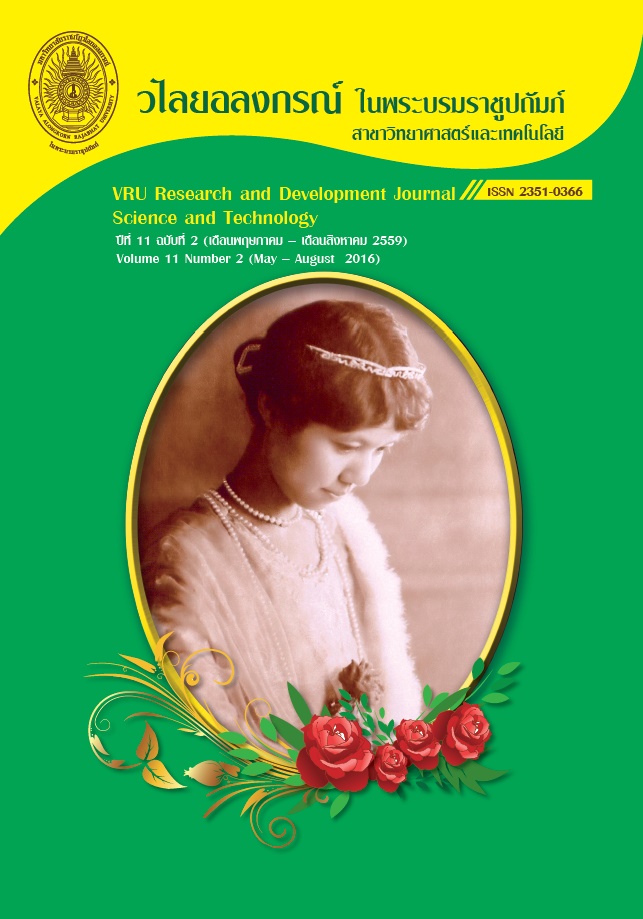ผลของแก่นตะวันต่อแบคทีเรียแลคติกในซอร์เบทโปรไบโอติก
Main Article Content
Abstract
แก่นตะวัน (Jerusalem artichoke) เป็นแหล่งของอินนูลินและฟรุคโตโอลิโกแซคคาร์ไรด์ที่มีคุณสมบัติเป็นพรีไบโอติก โดยงานวิจัยนี้แสดงให้เห็นว่าการเสริมแก่นตะวันผงทางการค้าลงในอาหารเลี้ยงเชื้อเหลว MRS สามารถส่งเสริมการเจริญเติบโตของแบคทีเรียแลคติก (Lactic Acid Bacteria, LAB) ได้ร้อยละ 121.08 ดังนั้นงานวิจัยนี้จึงศึกษาผลของการเสริมแก่นตะวันผงในซอร์เบทโปรไบโอติกที่มีต่อปริมาณ LAB ซอร์เบทโปรไบโอติกเป็นผลิตภัณฑ์ไอศกรีมชนิดหนึ่งที่เหมาะต่อการใช้เป็นตัวนำส่งโปรไบโอติกทางอาหารของมนุษย์ คุณภาพด้านหนึ่งที่สำคัญของผลิตภัณฑ์โปรไบโอติกคืออัตราการคงอยู่ของโปรไบโอติกในระหว่างอายุการเก็บรักษาผลิตภัณฑ์ งานวิจัยนี้จึงศึกษาปัจจัยที่มีผลต่อปริมาณ LAB ในซอร์เบทโปรไบโอติก ได้แก่ ระยะเวลาการบ่มซอร์เบทมิกซ์ (0 2 4 6 8 และ 10 ชั่วโมง) กระบวนการผลิต (การบ่ม การปั่น และการแช่แข็ง) ปริมาณแก่นตะวันผง (ร้อยละ 0 7 14 และ 21โดยน้ำหนักของซอร์เบทมิกซ์) และระยะเวลาการเก็บรักษา (1 7 14 และ 21วัน) ผลการศึกษาพบว่าระยะเวลาบ่มซอร์เบทมิกซ์ที่เหมาะสมคือ 6 ชั่วโมง ซึ่งทำให้มีปริมาณ LAB สูงที่สุดคือ 2.48X1011 CFU/mL (p≤0.05) ผลการศึกษาปัจจัยของปริมาณแก่นตะวันผงและกระบวนการผลิตพบว่าทั้งสองปัจจัยมีอิทธิพลร่วมกันต่อปริมาณ LAB โดยซอร์เบทมิกซ์ที่เสริมแก่นตะวันผงร้อยละ 21 ภายหลังการบ่มมีปริมาณ LAB สูงที่สุด (p≤0.05) อย่างไรก็ตามพบว่าปริมาณ LAB ในซอร์เบทโปรไบโอติกทุกสูตรภายหลังกระบวนการปั่นและการแช่แข็งไม่แตกต่างกัน (p>0.05) ผลการศึกษาอิทธิพลของปริมาณแก่นตะวันผงและระยะเวลาการเก็บรักษาต่อปริมาณ LAB พบว่าทั้งสองปัจจัยไม่มีอิทธิพลร่วมต่อกัน (p>0.05) แต่ผลการศึกษาแสดงให้เห็นว่าปริมาณแก่นตะวันผงที่เพิ่มขึ้นส่งผลให้ LAB มีปริมาณคงเหลือเพิ่มขึ้นในระหว่างการเก็บรักษา (p≤0.05) และพบว่าปริมาณแก่นตัวผงมีผลต่อคุณภาพทางประสาทสัมผัสของซอร์เบทโปรไบโอติก (ประเมินด้วยวิธี 9–Point Hedonic Scale) โดยซอร์เบทโปรไบโอติกที่เติมแก่นตะวันผงร้อยละ 21 ได้คะแนนความชอบด้านสี ความหวาน ความเรียบเนียน การละลายและความชอบรวมต่ำกว่าสูตรที่ไม่เติมและเติมแก่นตะวันผงร้อยละ 7 และ 14 (p≤0.05) ยกเว้นด้านกลิ่นที่คะแนนไม่แตกต่างจากสูตรที่ไม่เติมแก่นตะวันผง (p>0.05) แต่อย่างไรก็ตามการเสริมแก่นตะวันผงร้อยละ 14 ในซอร์เบทโปรไบโอติกเหมาะสมเนื่องด้วยให้ได้รับคะแนนการประเมินทางประสาทสัมผัสและ ปริมาณ LAB สูง
Jerusalem artichoke is a source of inulin and oligosaccharide which have prebiotic properties. This research demonstrated that supplementation commercial Jerusalem artichoke powder (JAP) in MRS broth could promote lactic acid bacteria (LAB) growth up to 121.08%. Therefore, the effect of JAP supplement in sorbet probiotic on amount of LAB was investigated. Sorbet is one of the ice cream products that seems suitable for delivering probiotics in human diet. One key aspect of probiotic product quality is survival rate of probiotic during the product shelf life. This research focused on the four factors affect the LAB count namely, incubation time of sorbet mix (0, 2, 4, 6, 8 and 10 hours), the processes of sorbet production (incubating, whipping, freezing), concentration of JAP (0, 7, 14 and 21% w/w of sorbet mix) and storage time (1, 7, 14 and 21 days). The results showed that optimum incubation time of probiotic sorbet was 6 hours, which resulted in the highest of LAB count at 2.48X1011 CFU / mL (p≤0.05). This study also found that JAP concentration and the processes of probiotic sorbet production had an interaction effect on LAB counts. The sorbet mix supplemented with 21% JAP after incubation process had the highest LAB counts (p≤0.05). Nevertheless, the LAB count of all probiotic sorbet formulas, after whipping and freezing processes, were not significantly different (p> 0.05). A study of the influence of the JAP concentration and storage time on LAB count showed no interaction (p> 0.05). However, this study demonstrated that higher concentration of JAP increased LAB cell viability during storage (p≤0.05). Moreover different JAP concentration affected the sensory characteristics (evaluated by 9-Point Hedonic Scale). Probiotic sorbets with 21% JAP had liking score of color, sweetness, smoothness, melting and overall lower than probiotic sorbet without and with JAP (7% and 14%) (p≤0.05), except liking score of smell which was not different (p> 0.05) from probiotic sorbet without JAP addition. Supplementing the probiotic sorbet with 14% JAP was recommended due to high score on sensorial acceptance and high amount of LAB.
Downloads
Article Details
Copyright Notice
The copyright of research articles published in the VRU Research and Development Journal Science and Technology Journal belongs to the Research and Development Institute, Valaya Alongkorn Rajabhat University under the Royal Patronage. Reproduction of the content, in whole or in part, is prohibited without prior written permission from the university.
Responsibility
The content published in the VRU Research and Development Journal Science and Technology Journal is the sole responsibility of the author(s). The journal does not assume responsibility for errors arising from the printing process.
References
นิมิตร วรสูต และสนั่น จอกลอย. 2549. อินนูลิน: สารสำคัญสำหรับสุขภาพในแก่นตะวัน. แก่นเกษตร. 34(2): 85–91.
ศิริพร ตันจอ, ครรชิต จุดประสงค์, ชนัญฑิตา ไชยโต และสนั่น จอกลอย. (2555). อินนูลินและฟรุกโตโอลิโกแซคคาไรค์ในแก่นตะวันสายพันธุ์ต่าง ๆ. วารสารวิจัย มข. 17(1): 25-34.
สำนักงานคณะกรรมการอาหารและยา. 2555. ประกาศกระทรวงสาธารณสุข เรื่อง การใช้จุลินทรีย์โปรไบโอติกในอาหารและประกาศกระทรวงสาธารณสุข.
เอกภพ สินงาม. (2555). การศึกษาคุณสมบัติความเป็นพรีไบโอติกของฟรุกโตโอลิโกแซคคาไรด์ที่ได้จาก แก่นตะวัน. วิทยานิพนธ์วิทยาศาสตรมหาบัณฑิต บัณฑิตวิทยาลัย, มหาวิทยาลัยศิลปากร.
Abghari, A., M. Sheikh-Zeinoddin and S. Soleimanian-Zad. (2011). Nonfermented ice cream as a carrier for Lactobacillus acidophilus and Lactobacillus rhamnosus. International Journal of Food Science and Technology. 46(1): 84-92.
Akalin, A. S. and D. Erişir (2008). Effects of inulin and oligofructose on the rheological characteristics and probiotic culture survival in low-fat probiotic ice cream. Journal of Food Science. 73(4): M184-M188.
Akin, M. B., M. S. Akin and Z. Kirmaci. (2007). Effects of inulin and sugar levels on the viability of yogurt and probiotic bacteria and the physical and sensory characteristics in probiotic ice-cream. Food Chemistry. 104(1): 93-99.
A.O.A.C. (2000). Official Methods of Analysis (17thed). Arlinton: Association of Official Analytical Chemists.
Goff D. H., R.W. Hartel. (2013). Ice cream (7th ed.). New York: Springer US
Homayouni, A., A. Azizi, M. R. Ehsani, M. S. Yarmand and S. H. Razavi. (2008). Effect of microencapsulation and resistant starch on the probiotic survival and sensory properties of symbiotic ice-cream. Food Chemistry. 111(1): 50-55.
Khampheng, P., N. Sunee and K. Suttipun. (2006). Isolation, screening and Identification of mannanase producing microorganisms. Kasetsart Journal. 40: 26-38.
Kolida, S., K. Tuohy and G. R. Gibson. (2002). Prebiotic effects of inulin and oligofructose. British Journal of Nutrition. 87(suppl.2): s193-s197.
Loo, J. V., P. Coussement, L. De Leenheer, H. Hoebreg and G. Smits. (1995). On the Presence of inulin and oligofructose as natural ingredients in the western diet. Critical Reviews in Food Science and Nutrition. 35(6): 525-552.
Paniyan, C., R. V. Annal, G. Kumaresan, B. Murugan and G. Rajarajan. (2012). Effect of incorporation of inulin on the survivability of Lactobacillus acidophilus in synbiotic ice cream. International Food Research Journal. 19(4): 1729-1732.
Silva, P. D. L. d., M. d. F. Bezerra, K. M. O. d. Santos and R. T. P. Correia. (2015). Potentially probiotic ice cream from goat's milk: Characterization and cell viability during processing, storage and simulated gastrointestinal conditions. LWT - Food Science and Technology. 62(1, Part 2): 452-457.
Tripathi, M. K. and S. K. Giri. (2014). Probiotic functional foods: Survival of probiotics during processing and storage. Journal of Functional Foods. 9: 225-241.
Wright V. A. and L. Axelsson. (2011). Lactic acid bacteria an introduction. In S. Lahtinen, A. C. Ouwehand, S. Salminen, A.V. Wright, eds. Lactic Acid Bacteria: Microbiological and Functional Aspects (4th). Florida: CRC Press.


